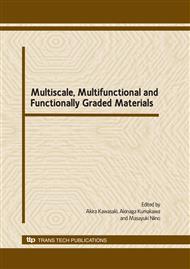p.367
p.373
p.379
p.387
p.393
p.401
p.407
p.413
p.425
Investigation on the Effect of Test Parameters on Small Punch Creep Tests by Finite Element Method
Abstract:
The small punch creep (SP-C) test technique is a new method which is applied to evaluate the high temperature creep properties of materials by using miniature specimen. In the present paper, the Finite Element Method (FEM) is employed to simulate the SP-C test in order to investigate the effects of test parameters on testing results of the SP-C test. In this attempt, we perform systematic numerical simulations of SP-C tests by changing friction coefficient, specimen thickness, the diameter of punch ball and the inner diameter of lower die, and discuss the effects of the variation of test parameters on test results in detail. The resulting regression equations for assessing the effects of testing parameters on test results are obtained. It is found that the test results are influenced significantly by the specimen thickness, the diameter of punch ball and the inner diameter of lower die. However, the effects of friction coefficient on the results of the SP-C test can be neglected.
Info:
Periodical:
Pages:
393-398
Citation:
Online since:
October 2009
Authors:
Price:
Сopyright:
© 2010 Trans Tech Publications Ltd. All Rights Reserved
Share:
Citation:


